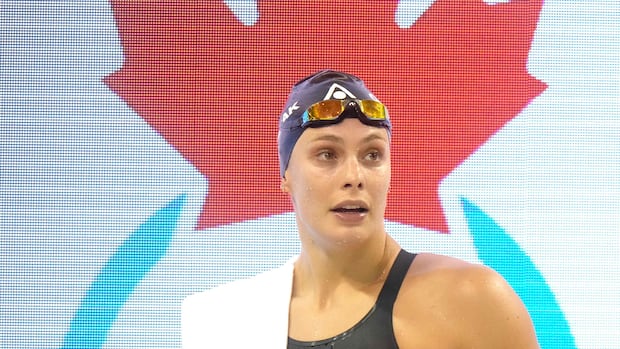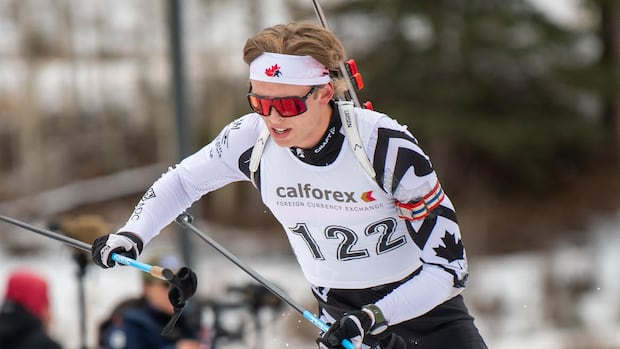Canadian swimmer Penny Oleksiak's two-year ban from competition has raised questions about the reasons for her suspension: three whereabouts failures.
In its World Anti-Doping Code, the World Anti-Doping Agency (WADA) defines a whereabouts failure as any combination of three missed drug tests or "filing failures" in a 12-month period.
Swimming Canada chief executive officer Suzanne Paulins said in a statement on Tuesday that the organization accepted Olesiak's explanation these "were inadvertent errors and she has not used banned substances."
Oleksiak is tied with sprinter Andre De Grasse as Canada's most decorated Olympian, having won seven medals over her career.
Here's what we know about the whereabouts program, the responsibilities of athletes who are part of the program, and potential violations of the program.
What is the whereabouts program?The whereabouts program is part of WADA's drug-testing program that applies to all international Olympic federations and their athletes, and also all national anti-doping organizations and the athletes subject to their rules.
The program requires certain athletes to submit information about their daily routine so they can be located for a random drug test.
Which athletes take part in the program?An identified group known as the Registered Testing Pool (RTP), a group of elite-level athletes who are generally believed to be at higher risk for doping and should be subjected to more testing.
Along with the very top athletes, the pool can include those coming off an injury, or those who have returned to competition after previously retiring. It can also include athletes whose performance has suddenly peaked.
Every sport in every country has its own criteria for determining who should be in the RTP, according to Janie Soublière, a lawyer who specializes in sports law and an arbitrator for dispute resolution in sports.
 Penny Oleksiak prepares to compete in a 100-metre freestyle event in Illinois in March. (Getty Images)How does the whereabouts program work?
Penny Oleksiak prepares to compete in a 100-metre freestyle event in Illinois in March. (Getty Images)How does the whereabouts program work?Athletes selected for the program have to provide information about their location for each day of the year, which they submit on a quarterly basis.
That information, which is submitted into WADA's management system, can include overnight accommodation, travel, work and training schedules, and also regular daily activities, said Kevin Bean, Sport Integrity Canada's executive director, anti-doping and competition manipulation.
Bean said this "general information" gives anti-doping organizations the ability to locate athletes for an unplanned test.
"So, if you go to work every day from nine to five, that would be in your whereabouts submission. If you train on Monday, Wednesday, Friday, Saturday, that's in your whereabouts submission," Bean said. It's also important that an athlete notes where they're staying every night, he added.
But that doesn’t mean athletes are responsible for outlining every minute of every day.
Instead, athletes in the RTP have to identify one hour of every day where they guarantee they’ll be in a specific location of their choosing.
"It has to be at a location that can be easily identifiable, easily found, and where [the athlete] can be easy located by a doping control officer," Soublière said.
A lot of athletes might choose an hour in the early morning when they know they’ll be at home, Bean said.
“You’re held 100 per cent accountable for that one hour,” he said.
WATCH | Oleksiak's former teammate discusses whereabouts rules:Olympic multi-medallist Penny Oleksiak has accepted a two-year ban from competitions due to three whereabouts failures. Her former teammate Brittany MacLean Campbell, host of The Ready Room on CBC Radio, discusses the rules and shares her perspective on the violations. How onerous is the program for athletes?Oleskiak's former teammate Brittany MacLean Campbell, host of CBC's The Ready Room, was also part of the whereabouts program.
"It is a little bit cumbersome for sure, but you start to get used to it and you also start to get a rhythm because it's quarterly," she said.
She said while in theory she was planning out her life three months in advance, she would know loosely where she was aiming to be training for certain weeks.
And every time Swimming Canada gave her a schedule for an upcoming competition, she said she would input travel information like the hotel she was staying at.
"They would have clear guidelines [to] make sure this is included in your whereabouts. It was upkeep but I don't think it was anything more than what I now have in life upkeep in other ways," MacLean Campbell said.
 From left, Brittany MacLean, Katerine Savard, Taylor Ruck and Penny Oleksiak celebrate their bronze medal in the women's 4x200-metre freestyle relay at the 2016 Olympics in Rio de Janeiro. (Sean Kilpatrick/The Canadian Press)
From left, Brittany MacLean, Katerine Savard, Taylor Ruck and Penny Oleksiak celebrate their bronze medal in the women's 4x200-metre freestyle relay at the 2016 Olympics in Rio de Janeiro. (Sean Kilpatrick/The Canadian Press)It's important to note that you can freely adjust your pre-arranged time, she added.
Athletes can do so basically up to the minute that the time is scheduled.
"It's impossible to know for three months what you're doing every day. So you fill out the general information and then you provide updates and changes as it goes along," Bean said.
What are considered whereabouts failures?The first type of whereabouts failure is not filing the information by the deadline.
Another type of failure would be, for example, if an athlete said they were in Ottawa, but they're actually competing at an event in Europe at the time, Bean said.
"That's failing to update your whereabouts or making sure it's accurate for a fairly significant event," he explained.
The third type of failure is not being available at a specific location during the hour they identified. That's considered a missed test.
If an athlete accumulates three of those failures in any combination over a 12-month period, they face sanction.
Is it common for athletes to accumulate 3 failures?Bean said his organization has seen a handful of whereabouts failure cases over the last number of years and they do happen internationally from time to time.
"It is rare but not completely infrequent," he said.
While the rules exist to catch out those athletes who might be trying to avoid testing, Bean said there also might be athletes who are "forgetful busy, caught up in something else and don't remember that this is part of their obligation."
He said he couldn't comment specifically on Oleksiak's case but that there's a significant amount of effort put into educating athletes on the whereabouts requirements.
That includes an online course that all athletes have to take, Bean said. Sport Integrity Canada also provides email reminders for the multiple points leading up to a filing deadline that remind the athletes what they need to do and when they need do it, he added.
MacLean Campbell said she's "100 per cent confident" Oleksiak is a clean athlete, but her ban raises questions as to how she let it get to that point.
"I won't make excuses for her, when you know you have two strikes and you're in a situation like this, that the severity is pretty high," she said.
But MacLean Campbell added it's also possible Oleksiak didn't realize the severity of her situation.
"I do think that this happens easier than people realize," she said.











